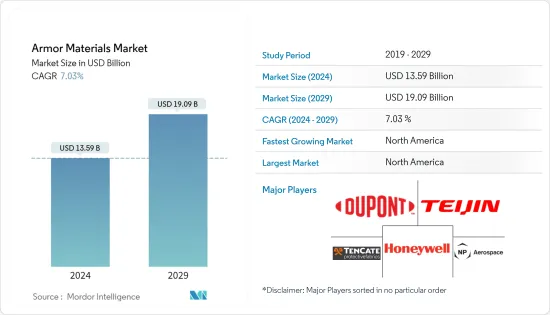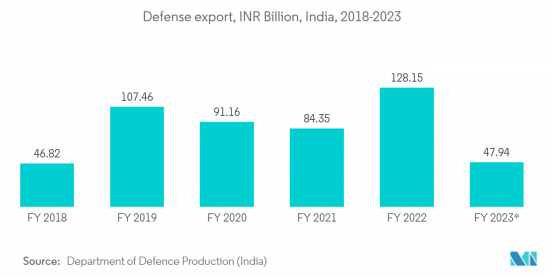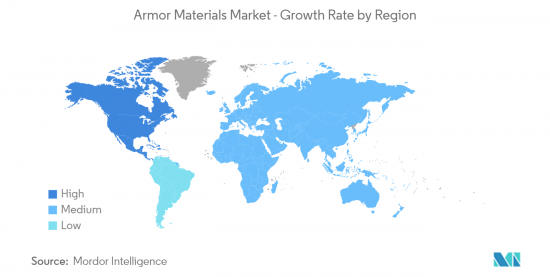 |
市場調査レポート
商品コード
1429239
装甲材料:市場シェア分析、産業動向と統計、成長予測(2024年~2029年)Armor Materials - Market Share Analysis, Industry Trends & Statistics, Growth Forecasts (2024 - 2029) |
||||||
● お客様のご希望に応じて、既存データの加工や未掲載情報(例:国別セグメント)の追加などの対応が可能です。 詳細はお問い合わせください。
| 装甲材料:市場シェア分析、産業動向と統計、成長予測(2024年~2029年) |
|
出版日: 2024年02月15日
発行: Mordor Intelligence
ページ情報: 英文 120 Pages
納期: 2~3営業日
|
- 全表示
- 概要
- 目次
2024年の装甲材料市場規模は135億9,000万米ドルと推定され、2029年には190億9,000万米ドルに達すると予測され、予測期間中(2024年~2029年)のCAGRは7.03%で成長します。

COVID-19関連の封鎖規制により、多くの製造業が停止しました。しかし、TenCate Advanced ArmorやNP Aerospaceなどいくつかの防具製造企業は、再組織化、従業員の安全確保、顧客への継続的な供給を行うための政府規制の遵守により、生産を継続しました。このような支障のない生産が、パンデミック時の装甲材料市場を押し上げました。
主なハイライト
- 短期的には、防護服と先端兵器の市場開拓と国土安全保障への関心の高まりが、調査対象市場の成長を促進する主な要因です。
- しかし、防衛製品の生産コストが高いことが、調査対象市場の成長を抑制する可能性が高いです。
- とはいえ、国防予算の増加と軍事近代化計画の高まりは、近い将来、世界市場に有利な成長機会をもたらす可能性が高いです。
- 北米が市場を独占し、最大のシェアを占めており、予測期間中も市場を独占すると予想されます。
装甲材市場の動向
ボディアーマー用途が市場をリードする見込み
- 国土安全保障上の懸念から、どの国でも十分な訓練を受けた防衛力の保有が必要となっています。国家間の二国間緊張の高まりにより、軍隊訓練の必要性が高まっています。
- 国土安全保障のために、兵士は戦うことを意味し、そのためには武器、車両、ボディシールドが必要です。中国は2022年、200万人以上の現役兵を擁し、現役兵数で世界最大の軍隊を有していました。上位5位はインド、米国、北朝鮮、ロシアです。
- ロシアは2022年に約864億米ドルを軍事費に費やし、前年比31%増となった。
- 防護服の着用はほぼ一般的な慣行であり、多くの場合、軍人や特殊部隊の間では必須です。
- 戦争中、兵士は防護服を着用し、銃や手榴弾などの武器を携帯しなければならないです。従って、戦争中は軍人がこれらを利用できるようにする必要があります。毎年、軍に入隊する人が増えており、防具や武器の需要がさらに高まっています。
- さらに、フィリピンは今後10年間で軍の近代化を計画しており、そのために250億PHP(~4億4,755万米ドル)を割り当てています。このプログラムの下で、フィリピン国軍(AFP)は、より多くの防護服、ライフル、ヘルメットとともに、より多くの夜間対応攻撃ヘリコプターと高速ボートを受け取ることが期待されています。
- さらに、国防生産省(インド)によると、2022会計年度、インドからの防衛装備品の輸出額は1,282億インドルピー(~16億3,000万米ドル)に達しました。
- 2022-23年度インド連邦予算によると、国防研究開発予算の25%が民間企業や新興企業に割り当てられ、インドにおける革新的な防衛技術開発の道が開かれました。
- スペイン政府は、2024年までに軍事費を約180億ユーロ(~189億7,000万米ドル)に増額する決定を発表しました。
- 以上のような要因から、予測期間中はボディアーマー部門が市場を独占すると予想されます。

北米が市場を独占する
- 北米は市場シェアで世界市場を独占しています。米国は、世界的にみて防具材料の最大消費国の一つです。
- これは主に、テロリズムによる国土安全保障上の懸念の高まりによるものです。米国は軍事費が最も高く、世界最大の軍事力を有しています。
- 米国陸軍の最新の予算文書によると、合計504ユニットの消防車両が調達される見込みで、2022年から2027年までに260ユニットが発注されます。
- さらに、米国陸軍とBAEシステムズは、新型装甲多目的車両の製造を加速させる方法を見つけるために協力しており、これにより同軍は老朽化したM113装甲兵員輸送車をより迅速に置き換えることができます。
- さらに、主要国間の地政学的・二国間的緊張の高まりとテロ活動の活発化により、防衛装備品を製造するための装甲材料の調達が増加しています。
- 米国はまた、サウジアラビアとF-35戦闘機の売却とともに、武器取引の重要な取引を行った。
- 国内最大の戦闘機メーカーであるロッキード・マーチンは、2023年までに年間生産量を約3倍の160機以上に増やす決定を発表しました。
- 米国陸軍も、予測期間中に軽量戦車の製造に約14億米ドルを費やす計画を発表しました。
- これらの要因によって、予測期間中、北米の装甲材料の需要が促進される可能性が高いです。

装甲材料産業の概要
装甲材料市場は元来統合型です。主な企業は、デュポン、Teijin Aramid B.V.、TenCate Protective Fabrics、NP Aerospace、Honeywell International Incなどである(順不同)。
その他の特典
- エクセル形式の市場予測(ME)シート
- 3ヶ月間のアナリスト・サポート
目次
第1章 イントロダクション
- 調査の前提条件
- 調査範囲
第2章 調査手法
第3章 エグゼクティブサマリー
第4章 市場力学
- 促進要因
- 防護服と先端兵器の開発
- 国土安全保障への関心の高まり
- その他の促進要因
- 抑制要因
- 防衛製品の生産コストの高騰
- その他
- 産業バリューチェーン分析
- ポーターのファイブフォース分析
- 供給企業の交渉力
- 買い手の交渉力
- 新規参入業者の脅威
- 代替品の脅威
- 競合の程度
第5章 市場セグメンテーション(金額ベース、市場規模)
- 製品タイプ
- 金属・合金
- セラミックと複合材
- パラ系アラミド繊維
- 超高分子量ポリエチレン
- その他の製品タイプ(ガラス繊維などを含む)
- 用途
- 航空宇宙
- 防護服
- 民間用装甲
- 船舶用装甲
- 車両用装甲
- 地域
- アジア太平洋
- 中国
- インド
- 日本
- 韓国
- その他のアジア太平洋
- 北米
- 米国
- カナダ
- メキシコ
- 欧州
- ドイツ
- 英国
- フランス
- イタリア
- その他の欧州
- 南米
- ブラジル
- アルゼンチン
- その他の南米
- 中東・アフリカ
- 南アフリカ
- サウジアラビア
- その他の中東・アフリカ
- アジア太平洋
第6章 競合情勢
- M&A、合弁事業、提携、協定
- 市場シェア(%)**/ランキング分析
- 主要企業の戦略
- 企業プロファイル
- 3M
- ARMORSOURCE, LLC.
- ATI
- CeramTec GmbH
- CoorsTek Inc.
- DSM
- DuPont
- Honeywell International Inc.
- HYOSUNG
- JPS Composite Materials
- TenCate Protective Fabrics
- Morgan Advanced Materials
- NP Aerospace
- PPG Industries, Inc.
- SAFEGUARDARMOR.COM
- Saint-Gobain
- Schunk Carbon Technology
- Tata Steel
- Teijin Aramid B.V.
第7章 市場機会と今後の動向
- 国防予算の増加
- 軍事近代化計画の増加
The Armor Materials Market size is estimated at USD 13.59 billion in 2024, and is expected to reach USD 19.09 billion by 2029, growing at a CAGR of 7.03% during the forecast period (2024-2029).

Due to COVID-19-related lockdown restrictions, many manufacturing industries came to a halt. However, several armor manufacturing companies, such as TenCate Advanced Armor and NP Aerospace, continued to run their production by re-organizing, ensuring the safety of employees, and following government regulations to provide continuous supply to customers. Such unhindered production boosted the armor materials market during the pandemic.
Key Highlights
- Over the short term, the development of body armor and advanced weapons and increasing homeland security concerns are major factors driving the growth of the market studied.
- However, high cost of production of defense products are likely to restrain the growth of the studied market.
- Nevertheless, increasing defense budget and rising military modernization programs are likely to create lucrative growth opportunities for the global market soon.
- North America dominated the market, holding the largest share, and is expected to dominate the market during the forecast period.
Armor Materials Market Trends
Body Armors Application expected to lead the Market
- Homeland security concerns have made it necessary for all countries to have well-trained defense forces. The requirement for army training is increasing owing to the increasing bilateral tensions between nations.
- For homeland security, soldiers are meant to fight, for which they require weapons, vehicles, and body shields to protect them. China had the world's largest armed forces in terms of active duty military personnel in 2022, with over 2 million active soldiers. The top five largest armies were India, the United States, North Korea, and Russia.
- Russia spent around USD 86.4 billion on its military expenses in 2022, having increased its spending by 31 percent over the previous year.
- Wearing body armor is almost a common practice, and in many instances, mandatory among military personnel and special forces, as they help reduce fatalities in military environments.
- During wars, soldiers have to wear body armor and carry weapons, such as guns, grenades, etc. Hence, these are to be made available to military personnel during wars. Every year, more individuals join the army, creating further demand for armor and weapons.
- Furthermore, Philippines is planning to modernize its military over the next decade and has allocated PHP 25 billion (~USD 447.55 million) for the same. Under this program, the Armed Forces of the Philippines (AFP) is expected to receive more night-capable attack helicopters and fast boats, along with more body armor, rifles, and helmets.
- Additionally, according to the Department of Defence Production (India), in the financial year 2022, the export value of defense equipment from India reached INR 128.2 billion (~USD 1.63 billion).
- According to the Union Budget 2022-23 of India, 25% of the defense R&D budget has been designated for private industry and start-ups, paving the door for the development of innovative defensive technology in India.
- The Spanish government has announced its decision to increase its military expenditure to approximately EUR 18 billion (~USD 18.97 billion) by 2024.
- Owing to all the above-mentioned factors, the body armors segment is expected to dominate the market during the forecast period.

North America to dominate the Market
- North America dominated the global market in terms of market share. The United States is one of the largest consumers of armor materials globally.
- This is majorly owing to the rising homeland security concerns due to terrorism. The United States has the highest military expenditure and has the largest military force globally.
- According to the US Army's most recent budget document, a total of 504 units of fire vehicles are expected to be procured with 260 being ordered through 2022-2027.
- Additionally, the US Army and BAE Systems are collaborating to find ways to speed up manufacturing of the new Armoured Multi-Purpose Vehicle, which would allow the service to replace aging M113 armored troop carriers more swiftly.
- Furthermore, the emerging geopolitical and bilateral tensions between the major nations and the increasing terrorist activities lead to the increasing procurement of armor materials to manufacture defense equipment.
- The United States also struck a significant deal with Saudi Arabia for arms deal sales, along with the sale of F-35 combat aircraft.
- Lockheed Martin, the largest domestic fighter jet manufacturer, announced its decision to nearly triple its annual production to more than 160 jets by 2023.
- The US army also announced its plans to spend about USD 1.4 billion on manufacturing lightweight tanks over the forecast period.
- These factors will likely drive the demand for armor materials in North America over the forecast period.

Armor Materials Industry Overview
The armor materials market is consolidated in nature. The major players include DuPont, Teijin Aramid B.V., TenCate Protective Fabrics, NP Aerospace, and Honeywell International Inc, among others (not in any particular order)
Additional Benefits:
- The market estimate (ME) sheet in Excel format
- 3 months of analyst support
TABLE OF CONTENTS
1 INTRODUCTION
- 1.1 Study Assumptions
- 1.2 Scope of the Study
2 RESEARCH METHODOLOGY
3 EXECUTIVE SUMMARY
4 MARKET DYNAMICS
- 4.1 Drivers
- 4.1.1 Development of Body Armor and Advanced Weapons
- 4.1.2 Increasing Homeland Security Concerns
- 4.1.3 Other Drivers
- 4.2 Restraints
- 4.2.1 High Cost Of Production Of Defense Products
- 4.2.2 Others
- 4.3 Industry Value Chain Analysis
- 4.4 Porter's Five Forces Analysis
- 4.4.1 Bargaining Power of Suppliers
- 4.4.2 Bargaining Power of Buyers
- 4.4.3 Threat of New Entrants
- 4.4.4 Threat of Substitute Products and Services
- 4.4.5 Degree of Competition
5 MARKET SEGMENTATION (Market Size in Value)
- 5.1 Product Type
- 5.1.1 Metal and Alloy
- 5.1.2 Ceramic and Composite
- 5.1.3 Para-aramid Fiber
- 5.1.4 Ultra-high-molecular-weight Polyethylene
- 5.1.5 Other Product Types (Including Fiber Glass, etc.)
- 5.2 Application
- 5.2.1 Aerospace
- 5.2.2 Body Armor
- 5.2.3 Civil Armor
- 5.2.4 Marine Armor
- 5.2.5 Vehicle Armor
- 5.3 Geography
- 5.3.1 Asia-Pacific
- 5.3.1.1 China
- 5.3.1.2 India
- 5.3.1.3 Japan
- 5.3.1.4 South Korea
- 5.3.1.5 Rest of Asia-Pacific
- 5.3.2 North America
- 5.3.2.1 United States
- 5.3.2.2 Canada
- 5.3.2.3 Mexico
- 5.3.3 Europe
- 5.3.3.1 Germany
- 5.3.3.2 United Kingdom
- 5.3.3.3 France
- 5.3.3.4 Italy
- 5.3.3.5 Rest of Europe
- 5.3.4 South America
- 5.3.4.1 Brazil
- 5.3.4.2 Argentina
- 5.3.4.3 Rest of South America
- 5.3.5 Middle East and Africa
- 5.3.5.1 South Africa
- 5.3.5.2 Saudi Arabia
- 5.3.5.3 Rest of Middle East and Africa
- 5.3.1 Asia-Pacific
6 COMPETITIVE LANDSCAPE
- 6.1 Mergers and Acquisitions, Joint Ventures, Colaborations and Agreements
- 6.2 Market Share (%)**/Ranking Analysis
- 6.3 Strategies Adopted by Leading Players
- 6.4 Company Profiles
- 6.4.1 3M
- 6.4.2 ARMORSOURCE, LLC.
- 6.4.3 ATI
- 6.4.4 CeramTec GmbH
- 6.4.5 CoorsTek Inc.
- 6.4.6 DSM
- 6.4.7 DuPont
- 6.4.8 Honeywell International Inc.
- 6.4.9 HYOSUNG
- 6.4.10 JPS Composite Materials
- 6.4.11 TenCate Protective Fabrics
- 6.4.12 Morgan Advanced Materials
- 6.4.13 NP Aerospace
- 6.4.14 PPG Industries, Inc.
- 6.4.15 SAFEGUARDARMOR.COM
- 6.4.16 Saint-Gobain
- 6.4.17 Schunk Carbon Technology
- 6.4.18 Tata Steel
- 6.4.19 Teijin Aramid B.V.
7 MARKET OPPORTUNITIES AND FUTURE TRENDS
- 7.1 Increasing Defense Budget
- 7.2 Rising Military Modernization Programs
